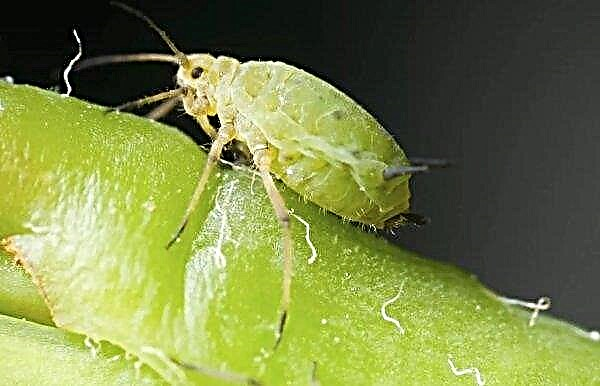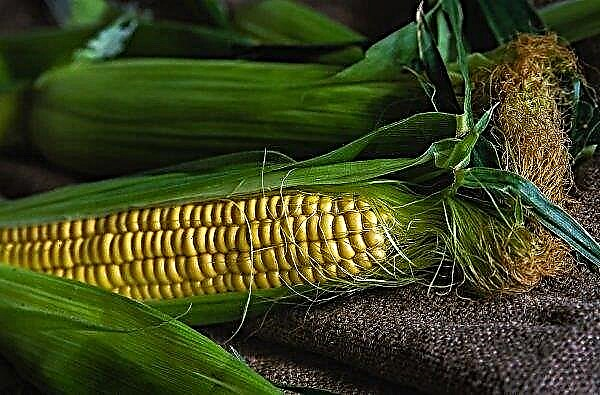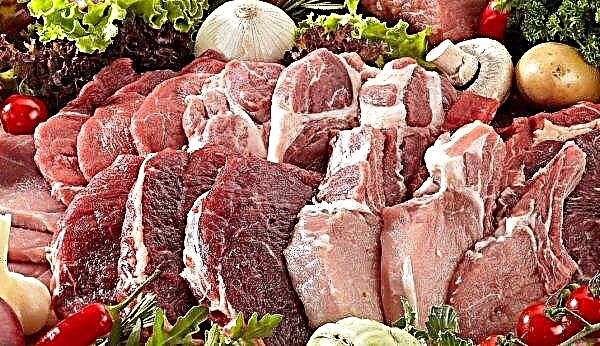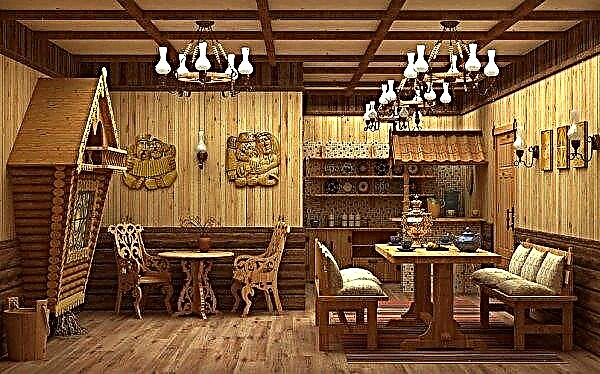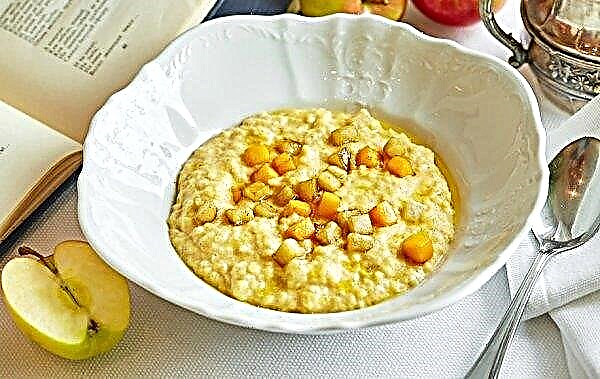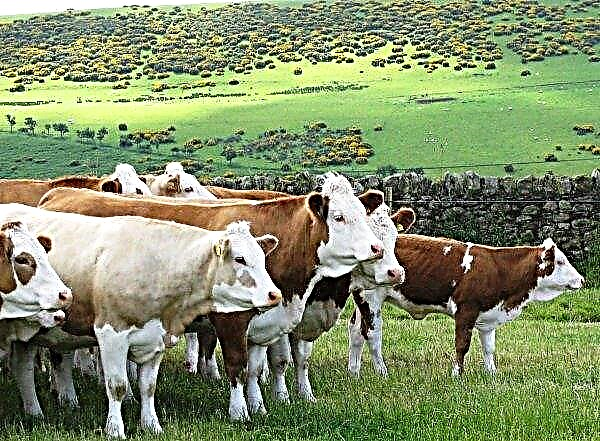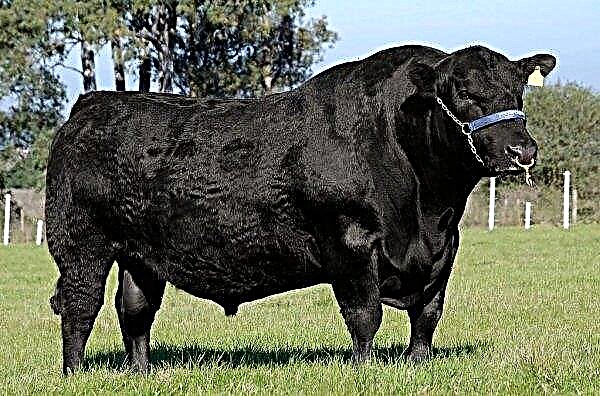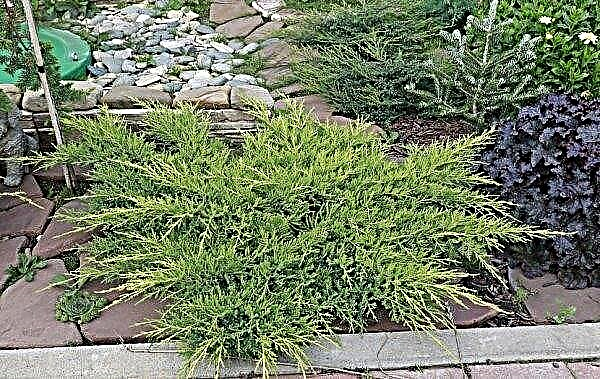Along with pines, arborvitae and decorative firs, junipers are often used by landscape designers to plant private areas, which is not surprising given the wide species and varietal diversity of plants of this genus. Which of them are the most popular today and what you should know about the basic rules of their cultivation - read on.
Juniper Description
Common juniper, or as it is also called “heather”, is a representative of the Cypress family and is characterized by the presence of a variety of forms and sizes of crowns, which directly depend on the variety of a particular specimen. Column-shaped crops can be used to create hedges, and more compact ornamental shrubs will be a good accent when creating rock gardens and rockeries.
The height of tree-like varieties of adult juniper often reaches 10–18 m, while bushy plants grow up to a maximum of four meters. On light brown shoots, coniferous (in young juniper) or scaly (in older specimens) green leaves are pressed to the branches. All of them are opposite in pairs or assembled in three-membered whorls.
Did you know? Juniper has been growing on our planet since time immemorial, and very often people have endowed it with mystical powers. For example, in biblical times, the plant was considered a talisman from troubles, therefore, before leaving the house, the traveler was recommended to take along a branch of culture, which was to make his path easy and trouble-free.
During the flowering period (begins mainly in April), you will not see lush pink or white flowers, but green and hard coniferous berries that are formed by autumn will be more noticeable than flowering branches. Such fruits reach their full ripening only by the next fall, while becoming softer, darker, with a slight bluish tint (as if covered with a bluish coating).

The brown trihedral seeds inside the fruits are oblong and covered with a hard shell that protects them from mechanical damage. At the same time on one plant can be both annual young cones and quite mature - biennial specimens.
The variety of juniper varieties that exist today allows gardeners to choose ornamental plants with narrow cylindrical, pyramidal, wide-columned or falling down crowns that tolerate shearing and are quickly restored. The root system of juniper is of a superficial type, therefore, the culture is characterized by increased moisture solubility and requires a responsible approach to loosening the site.
Video: Types and varieties of juniper
Juniper Species
Today in the world there are more than a dozen species of juniper. Some of them are more suitable for cultivation throughout Russia, while others can be planted only in the suburbs or in the south of the country, so before deciding on your decision, you should learn more about the most common options.
These include the following types of described conifers:
- Tall (in Latin "Juniperus excelsa"). It is represented by monoecious trees, with a maximum trunk height of up to 14-15 m (listed in the Red Book). Such junipers are found mainly in the Crimea and are characterized by a dense, conical crown at the beginning of their development and more rounded outlines of adult specimens. Thin branches with bluish-green, scaly needles on young shoots and needle-shaped on old ones depart from the runaway trunk. Fruits - spherical cone-berries of a violet-black color, with a bluish-white coating on the surface. In the early years, high juniper is characterized by a modest growth rate, but tolerates a haircut and is undemanding to care for. After five years of cultivation, crop growth accelerates.

- Pyramidal. It is considered the cultural form of common juniper and is a small tree (up to 5 m in height), the crown of which resembles a narrow pyramid. The ascending branches are tightly pressed against the trunk of the plant and are covered with short, soft needles of a dark green color. The external features of this plant make it look like cypress, popular in horticulture, and allow it to be used as an understory in pine-birch park plantings. Almost all varietal varieties of this species are characterized by high drought and frost resistance, not to mention the low demands on planting and further care.

- Prickly juniper (it is also called “red”) - these are shrubby forms or small evergreen trees, five to ten meters high, with an ovoid-cone-shaped crown within 1 m wide. Annual shoots are colored reddish or yellow-brown, but darken with age. . All branches are straight, but they can either rush up or grow to the sides. The leaves are saturated green, linear, pointed at the ends and devoid of longitudinal stripes. Glossy spherical fruits appearing in the fall are single, almost sessile, with a diameter of 5 to 12 mm. Seeds are broadly ovoid, trihedral.

- Chinese. It occurs in the mountains of the Southeast part of Asia. Due to its slow growth (not more than 20 cm per year) it is often used to decorate rocky slides, including when grown using the bonsai technique. Shrubs or trees of the species can be either monoecious or dioecious, often growing up to 20–25 m. The crown is broad-pyramidal, columnar or narrow-conical, although round and creeping juniper varieties can be found among shrub varieties. The dark green shoots are usually thin and slightly rounded, 1-2 mm thick. The needles can be of two types: scaly or needle-shaped, which also, for the most part, depends on the age of the crop. Spherical or slightly elongated cones at the initial stages of growth are covered with white coating, but later become dark blue and even almost black, with a diameter of up to 9 mm. Seeds ripen only in the second year after the appearance of cones.

- Ordinary. This species is represented mainly by shrubby forms of plants, no more than three meters high. Tree-like options are rare, but can grow up to 12 m. The shape of the crown depends on the age of the juniper, therefore, at the initial stages of cultivation, it appears conical or ovoid, but in the future more and more hanging branches appear on it, especially when it comes to female plants . The bark on the shoots is a reddish-brown color, while the trunk has a grayish-brown color. The leaves are stiff, spiky, almost triangular in shape with small grooves in the upper part. Some rings form from them, which remain on the branches for four years. The fruits are cone-shaped, and the male variants are almost sessile and yellowish in color, and the female ones are oblong-ovoid or more spherical, pale green or black-blue, with a slight blue tint or without it. For the first time, seeds can be collected for the further cultivation of common juniper no earlier than 5–10 years after planting the mother plant.

- Scaly. Junipers include densely branched shrub plants no more than 1.5 m high. Silver-blue needles, located in whorls of three each, reach a length of 0.5–0.8 cm. Shoots are green-brown in color and grow in the direction different sides, which makes the bush voluminous, but not too neat. Fruits - cones are dark blue in color, with a whitish waxy coating on the surface. This is an excellent option for single or group landings, and its additional advantage is the ability to land on slopes and slopes of sites for better fortification.
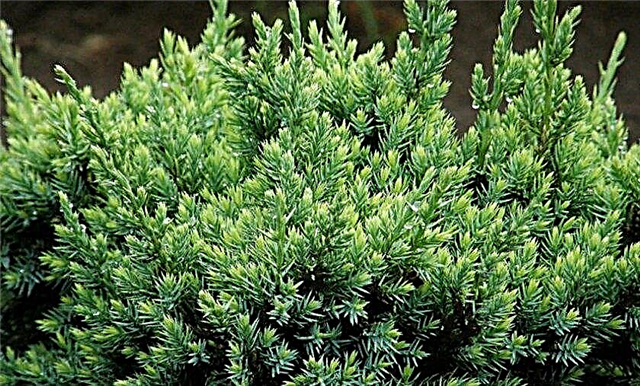
- Ground cover Juniper differs from shrubby and tree-like forms in long, sprouting flexible shoots on the ground, while the height of the plant in the central part does not exceed 30 cm.The overgrown plants form an excellent groundcover and can be used to create low borders, decorate slopes or rocky gardens. Like other varieties, groundcover plants have bluish-green needles and coniferous berries forming closer to autumn. This species can also include horizontal and lying versions of this culture, some varieties of the common or coastal species.

- Spreading. Such junipers are not only spreading, but also have a fairly high crown, with a diameter of up to four meters. Occasionally, you can find varieties of compact sizes, which are perfect for creating hedges and group compositions. This includes both tree-like and shrubby forms of culture, because the spreading crown will be the basis for their belonging to the species. The color of shoots, needles and fruits are practically no different from the above species.

- Horizontal. This juniper is often called ground cover. Most of the plants are dioecious cultures, growing up to 50 cm, with a crown width of 1.5–2 m in diameter. The annual growth of their shoots is not more than 5-10 cm per year, which makes the culture an excellent option for decorative landscaping of any territory. Young shoots are tetrahedral, slightly bluish and stand out well against the background of older branches. The color of the needles depends on the variety (for example, Limeglow has golden yellow needles), and the fruits are always dark blue, sometimes almost completely black in the shape of a sphere (reach a length of 6 mm). Due to its wind resistance and dwarf size, horizontal juniper is sometimes called flat.

- Deltoid (other names are "Tatar" or "Crimean"). It is represented by shrubby or tree-like forms of plants whose height is about 6 m. The trunk of such a juniper is covered with light gray bark, but two-year-old shoots are always a little darker. Leaves - as close as possible to each other, slightly protruding, linearly needle-shaped and pointed at the ends. In the upper part on the surface there are two white stripes, and below is a narrow and sharp keel. Brown cones in shape resemble an even ball with a diameter of 7–10 mm. The plant takes root well in Russian gardens and is suitable for landscaping plots in a variety of ways.

- Garden. This type of juniper combines all the most suitable for growing in the garden specimens. It can be either 15-centimeter juniper varieties spreading on the ground, or 10-meter large trees, single or bisexual. Shoots are often thin and long, but in some plants they can be almost curly, with falling extreme parts. The kidneys, in most cases, are bare, and the sheets are scaly or needle-like, of any shade of green.

- Weeping. Such junipers got their name because of hanging shoots, which in some cases only slightly slope to the ground, and in others they reach the surface of the earth. The plants themselves are predominantly represented by a tree form, 1.5–4 m high or slightly higher. Needles are usually needle-shaped, bluish-green in color, but may also have a brighter, more saturated color, which depends on the characteristics of a particular variety. Shrubs are occasionally referred to this species, but they are all medium or tall, at least 1.5 m in height.

- Virginia. It is found in the wild on river banks and on mountain slopes blown by winds, deservedly considered to be the most unpretentious among all possible cultural options. At home cultivation, up to 10 varietal varieties of Virginian juniper are planted in the plots, and among them there are shrubs up to 1.5-2 m high, and tree-like crops reaching 15 m in height. The shape of the crown and the color of the needles can also vary depending on the characteristics of a particular variety: weeping bluish-green specimens and pyramidal shrubs or trees more saturated with color are distinguished. The dwarf form of this species does not grow above 0.5 m with a crown width of 1.5 m.
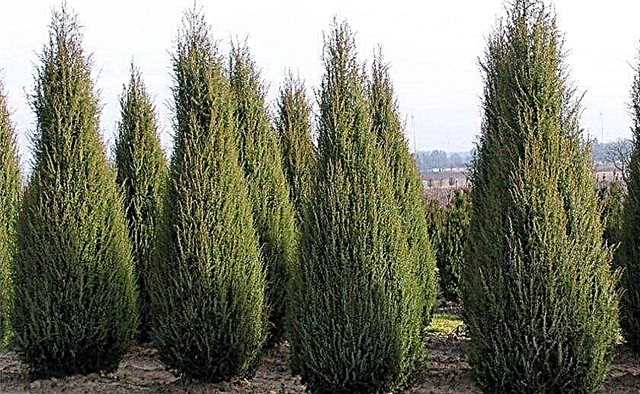
- European. This group often includes common juniper plants, growing in the European part of Russia. Such bushes and trees grow more slowly than representatives of the usual form and are practically devoid of hanging parts. Otherwise, the color of the needles and its “appearance” are not much different from the ordinary look.

- East African or slender juniper is a dioecious tree-like plant reaching 40 meters in height. For home growing, this is not a suitable option, but in the wild it can be found mainly in Africa, in particular, in the mountainous regions of the mainland. Like other varieties, gray-green needles are combined into whorls of 3 pieces each, the cones are blue-black in color with a wax coating and 2–5 separate seeds inside. In landscape design, a plant can be used only if it is regularly pruned and shoot growth is limited.

- Mountain (also called "juniper" or "Turkmen juniper"). So called the most different types of juniper, growing on the slopes of the mountains of Kopetdag, Big Balkhan, as well as in other rocky regions of Turkmenistan or Kazakhstan. Usually these are evergreen trees, reaching a height of 10 meters, with a crown diameter of not more than 50-60 cm. The bark is reddish and flaky, and the fruits look like black cone berries with two or four seeds inside. Sometimes “mountain juniper” is also called culture bushes growing in that area up to 2 meters high. Their gray-green needles are mostly needle-shaped, but sometimes scaly forms are also found.

- Rocky. This type of juniper is represented by dioecious shrubby forms of plants or low trees, not more than 10 meters high, with a trunk about 1 m in diameter. A characteristic feature of such plants is the low formation of a conical crown (begins almost at the base), which becomes rounded with age. Young shoots have weakly expressed 4 faces and a light, bluish-green bark. Leaf plates - opposite, scaly, ovoid or ovoid-rhombic in shape, with a blunt ending. Needle-shaped leaf forms are found a little less often, but they are all characterized by a length of up to 12 mm. The spherical cone berries are dark blue in color with a bluish bluish coating on the surface. According to external data, this species is closest to virgin, except that the shoots are a little thinner.

- Cossack (sometimes mistakenly called Caucasian). This species combines winter-hardy shrubs spreading on the ground (up to 1 m), which are found in the natural environment in Asia and in European forests. With the help of these plants it is good to strengthen rocky slopes, so they are often planted in places with frequent landslides. The shape of the crown can be either spreading, or pillow-shaped or spherical, and the color of the needle-like needles varies from light to bluish-green tones. Fruits are brown cones.

Conventionally, several more species of juniper can be distinguished, and the main criteria for their distribution into groups in this case will be such characteristics:
- rapid crop growth (with shoot growth of at least 20 cm per year);
- resistance to winter temperature drops (many varieties do not require winter shelter even when the thermometer columns are reduced to -35 ... -40 ° C);
- the possibility of growing in shady areas;
- vertical growth of shoots of a bush;
- high decorative qualities;
- the shape of the crown and the type of foliage (for example, conical or blunt).
Of course, junipers of very different varieties can be fast-growing, frost-resistant, shade-tolerant, vertical, bush or cone-shaped crops, each of which presents its own requirements for growing conditions. To get a highly decorative culture, you cannot ignore them.

Juniper Varieties
Each of the above plant species usually combines more than a dozen varieties of culture. When landscaping the site, the most popular are horizontal, ground cover, low-growing varietal varieties, although tall columnar plants may well become material for creating hedges.
The following varieties are deservedly considered popular plants from the first group:
- Sargent. This evergreen, creeping culture has one well-defined central trunk and many lateral processes that give the shrub extra volume. The maximum height is up to 80 cm with an annual growth of shoots in the aisles of 0.5 cm. Scaly needles are characterized by a bluish-green color, and on young plants it is light green. The cones are small, dark blue or black.

- Blue Pacific. Slow-growing representative of the coastal variety of shrub juniper, with a height of adult plants no more than 40 cm, with a crown width of 1.8 m. Branches are long and stretching, green-blue needles are needle-shaped. The plant is shade-hardy, frost-resistant, can be grown in the city and tolerant of prolonged drought.

- Glauka - a variety of horizontal, ground cover juniper, about 40 cm high and 2.5 m wide. The annual growth of shoots is 4–8 cm. The needles are soft to the touch, green-blue or with a steel tint, do not change color during the year. Fruits are fleshy, numerous cone berries with a bluish coating on the surface.

- Goldshatz (Goldschatz). This groundcover culture differs from other varieties in the bright golden color of the needles. The size of the 10-year-old specimen is 30 cm in height, but long shoots can spread 1.5 m in different directions. Scaly needles are painted orange-yellow in spring, and become bright golden in summer.

- Blue Compact. Another creeping and slow-growing juniper with the following parameters: growth - 50 cm, crown diameter - about 1 m. Young branches are predominantly green in color, with drooping tips. The needles are gray-blue, but in the sun its color seems more saturated.

- Agnieszka - a variety that is also horizontal, with a plant height of not more than 40 cm and a crown diameter of up to 2 m. It grows slowly, and with age it changes shape from pillow-shaped to open. The needles on the long shoots are two-type: in the warm season, it is bulging, small and densely packed, bluish-green or blue, and after frosts it becomes lilac at first, and then changes its color to reddish. Blue-violet fruits are rarely formed.

- Pancake (hor. Pancake) - horizontal juniper, with a bluish-green color of leaves (for most of the year). Ground cover bushes are no more than 1 m in height, with a width of lianoid branches of 1.5 m. All of them are painted in green-brown color and are located close to each other. The green mass of the Pancake variety is small, dense and by winter changes its bluish tint to a bronze tint.

- Glacier (Glacier) - a variety of horizontal juniper, which can be used as a groundcover. The height of the culture is only 10 cm, but the branches grow to the sides up to 1.5 m. The needles are a scaly type, blue-emerald color in the summer, which turn slightly brown in winter.

- Jade river (Jade River) - horizontal low juniper with bushes not more than 25 cm high. Long shoots form a flat crown, the diameter of which is up to two meters. Scaly-looking young needles become more needle-shaped and prickly with age, changing their color depending on the season of the year: in spring - bluish-blue, and in winter - brown.

- Leningrad (belongs to the Daurian species). It is a ground cover, creeping shrub, reaching a height of about half a meter. Thin branches have weakly expressed four faces and are complemented by green-blue scaly needles. Fruits are single, in shape resembling a ball, and their surface is painted dark blue with a bluish tint.

- Golden (or "Golden") Wings - a representative of a coastal species, the height of a ten-year bush is not more than 20–30 cm, diameter is 60–70 cm. The maximum width of the spreading crown is a little more than one meter. Yellow-green decorative needles - needle type, medium length and moderately prickly.

- Spotty spreader (Spotty Spreader) - a creeping, horizontal variety, with a dark green base of relatively soft needles and a white or cream color on its tips. The height of plants at the age of ten is approximately 15–20 cm, and the branches of the crown grow to 2 m in width.

- Yellow Sapphire (Yellow Sapphire) - a low shrub with a thickened, compressed crown of a flat spherical shape. Needles of unusual yellow color, which is characteristic for plants, regardless of the season. Juniper Juniper Yellow Sapphire reaches a height of 30 cm with a crown width of not more than 1 m.

- Variegata - a representative of the Cossack type of culture, presented in the form of a low shrub - up to 60 cm in height and 1.5 m in width. For the most part, its needles are scaly, gray-emerald color, with infrequent chaotic cream-green strokes.

Among the shrubby and medium-tall tree-like junipers for home cultivation on the territory, the following options will be suitable:
- Meyeri. The variety belongs to a scaly type of plants and is represented by evergreen highly decorative shrubs with an unusual color of needles: some of the branches (obliquely spaced) have silver-blue ends that distinguish the culture against the green background of other varieties. The maximum height of Meyeri plants is 3-4 m with a width of 1-2 m (10-year-old specimens reach only 1 m). The crown is thick and sprawling, with hanging parts of the lateral branches and a short needle-shaped needles of silver-blue color. Fruits - berry-like cones of gray-blue color and a bluish coating on the surface.
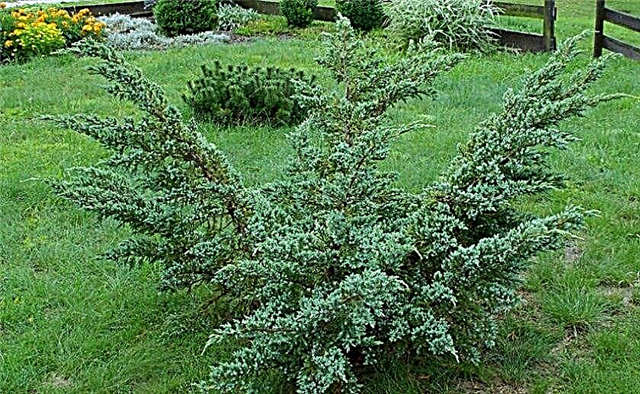
- Plumeza Aurea. Deservedly considered one of the most beautiful yellow varieties of culture with incredibly soft needles. The height of this shrub is 2 m, but in width it can grow up to 3 m. The crown is spreading, consisting of hanging branches with golden yellow needles in spring or bronze-yellow needles in winter.

- Bleu Spider (Blue Spider). Another representative of squamous juniper. The bush is medium-sized (up to 1.5 m, with a width of about 2.5 m), slowly growing (shoot growth is not more than 3.5 cm per year), with a spherical or asymmetric, cushion-like crown. The branches of the plant are flowing and creeping, but the tips of the brown shoots are raised up. The needles are hard, prickly to the touch. In winter, the emerald color changes to gray with a metallic tint.

- Hannethorp (Hunnetorp). Variety with a dense cover of scaly type on a large evergreen shrub with a funnel-shaped silver-blue crown. The height of the adult culture is 1.5 m, and the bush width corresponds to 1.8 m. In total, a plant can add about 10 cm in a year of growing.

- Golden flame. Another shrubbery juniper, the parameters of which correspond to 1.5 m in height and 2.5 m in width with an annual growth of shoots within 20 cm. The plant is branched, with branch ends pointing upward. Green-blue needles densely cover the shoots, needle-like, sometimes shimmering with a light cream shade of individual needles. Fruits - round and small, dark blue.

- Dubs frosted - ornamental shrub at the age of 10 up to 1 m high and 1.5 m wide. Young needles are golden yellow and contrast well with last year’s blue-green needles. The shape of the crown is flat-round, asymmetrical.

- Lodery - Slow-growing juniper bush, which after 10 years of cultivation reaches 80 cm, with the same width of the conical crown. Needle-shaped needles - short, dense, standard gray-green color.

- Bloow (Blaauw). This Chinese juniper is characterized by a slow growth rate and can reach a maximum of one and a half meters in height. In width, the bush grows by a meter, and at the initial stages of cultivation it is characterized by an unusual shape of an inverted cone, later becoming like a mace. The needles are short, gray-blue in color, scaly at the ends and needle-shaped at the base.

- Wichita Blue - a pyramidal rock juniper with a blue-emerald color of short needle needles in the spring and a silver-gray tint in the winter. The height of this erect plant reaches 6 m with a crown width of 1.5 m. In the rocky mountains of the northern part of America, such bushes often form thickets.

- Depress Aurea. Low-grade with unusual yellow needles. The height of an adult bush reaches two meters, and the crown spreads 2 meters wide. Branches - raised, evenly spaced on all sides. The young needles are of a rich yellow color, but with age changes color to copper-brown.

- Springbank - rocky juniper with a narrow, conical crown and long hanging branches. The height of the central shoots of the tree culture is 4 m, and the crown diameter is only 80 cm. The dense, prickly needles of plants of this variety are characterized by high decorativeness, largely due to the unusual blue color with a silver tint.

- Burki - a representative of the Virginian species of junipers, which at the age of 10 reaches a height of 2.5–3 m with a diameter of the pyramidal crown of the plant not less than two meters. Branches are evenly distributed over the entire width, and densely covered with bluish-green needles, which, when the colds come, changes its color to purple. More compact than another Virgin variety, Canaertii.

- Gold Cohn - a tree-like variety of juniper with vertically growing straight shoots and their ends slightly hanging down. The height of the adult culture is 1.5–2 m, and the diameter of the columnar or narrow-conical crown will rarely exceed 50 cm. The thick golden needles are needle-shaped, quite prickly and have three sides.

- Canaerty - a representative of the fast-growing colonized group of junipers up to 8 m high and a crown diameter of about 2-3 m. Young shoots are covered with scaly needles, but with age it becomes more needle-like, while maintaining its bright green color. The length of the needles is 5–7 mm.

- Schneverdinger Goldmengel - a medium-sized, tree-like variety whose adult plants often grow up to 4-5 m in height and 1 m in width. The crown is vertical, narrow, with the main shoots deflected from the center. The needles are needle-shaped, sparse, golden-yellow in young shoots and darker in biennials or older.

The basic rules of growing
To keep the selected variety as decorative as possible, a gardener should adhere to some recommendations for planting and caring for plants.
Important! Not all of the listed crops will grow equally well in a particular area, so before planting, make sure that the illumination and soil composition at the planting site is suitable for the selected specimen.
First of all, it is worth paying attention to the following cultural requirements:
- The landing site should be well lit by sunlight, with possible light partial shade during the daytime (some varieties grow well even in such conditions).
- The root neck of the seedling during planting should rise above the ground by several centimeters with a maximum depth of the landing pit of 70 cm.
- Between adjacent bushes should be at least 1–2.5 m of free space, depending on the size of the adult plant of the selected variety.
- In the process of after-planting care, special attention should be paid to watering, since most junipers are deservedly considered moisture-loving crops. On average, it is enough to moisten the soil for plants 2-3 times per season, focusing on the state of the upper soil layer in its near-stem zone (at least 10–20 l of liquid is used once per bush).
- Coniferous top dressing should be carried out once every 1-2 years using ready-made mineral fertilizers (for example, nitroammofoski or Kemira Universal).
- Loosening the soil must be carried out very carefully so as not to damage the surface roots of the culture. In general, a slight swelling of the substrate is sufficient with the next removal of weeds from the trunk zone of the juniper.
- Pruning of most varieties can be both formative and sanitary, since the branches of plants can quickly recover after damage. It is better to perform the procedure in early spring or already in autumn, although there is no fundamental difference in the choice of specific dates.
 Almost all varieties of juniper love the sun, therefore, when planting in the shade (this applies to the Cossack variety), the crown can be lightened and discolored.
Almost all varieties of juniper love the sun, therefore, when planting in the shade (this applies to the Cossack variety), the crown can be lightened and discolored.All described species and varietal varieties of juniper have high decorative properties and can be used for any type of gardening of a personal plot. However, knowledge of the basics of planting and the rules for further care will help to maintain their attractiveness for many years, because the life of most of these plants is not limited to several tens of years.
















































